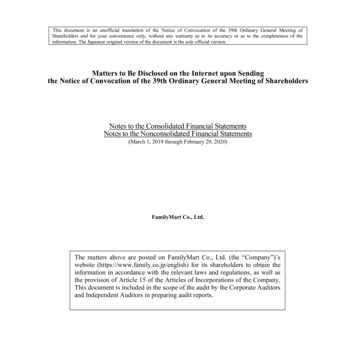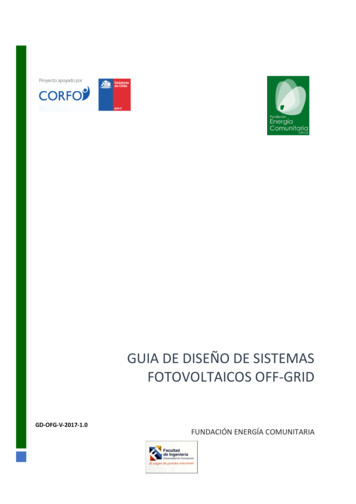
Transcription
Journal of Research in Rural Education, 2011, 26(11)Sending Off All Your Good Treasures: Rural Schools,Brain-Drain, and Community Survival in theWake of Economic CollapseJennifer ShermanRayna SageWashington State UniversityCitation: Sherman. J. & Sage, R. (2011). Sending off all your good treasures: Rural schools, braindrain, and community survival in the wake of economic collapse. Journal of Research in RuralEducation, 26(11). Retrieved from http://jrre.psu.edu/articles/26-11.pdf.Based in qualitative interviews and ethnographic research conducted in the remote rural town of “Golden Valley,” California, this paper explores the roles of schools and education in structuring rural community life in the wake of economic devastation caused by the timber industry collapse in the region. We look in depth at the ways in which education is either valuedor rejected by community residents in their struggles to keep their children nearby and promote a viable future for their community. We critically investigate the ways in which brain drain is perpetuated within the community, and how moral categories constructed around perceptions of a family’s moral worth influence the amount of encouragement or support childrenreceive with regard to education and future prospects within or outside of the community. We find that in the new economiclandscape, moral and class divisions within the community are magnified and reproduced through the local school system,with results that may consign some young adults to a life outside of the community, and others to chronic economic insecurity.Golden Valley,1 California, a small, remote community in the northern forested region of the state, was oncea bustling logging town with an economy tied heavily tothe timber industry. Generations of its men needed littleformal education to make a respectable living there, oftenlearning skills from their own fathers as teenagers, and transitioning to full time work in the forest sector rather thanfinishing high school. Women frequently married young,and tended homesteads and children rather than workingfor pay, relying on their husbands’ incomes to support thefamilies. Things changed permanently in 1990 with thespotted owl ruling,2 which banned timber harvesting in theowl’s habitat. The resulting closure of the local forests tologging set off a chain reaction that resulted in the closureof the local sawmills and the loss of jobs in most timberrelated sectors of the economy. The last sawmill closed in1996, taking 150 of the best remaining (men’s) jobs withit. By 2003, when this research was conducted, the community was an economic black hole, with the few linger-Correspondence regarding this manuscript should beaddressed to: Dr. Jennifer Sherman, Washington State University,Department of Sociology, 2710 University Drive, Richland, WA99354; Phone: 509-372-7239; Email: jennifer sherman@wsu.edu.1All names, including those of people and places, have beenchanged to protect the confidentiality of participants.2The 1990 listing of the northern spotted owl as threatenedunder the Endangered Species Act led to Federally-enforcedreductions of timber harvesting through much of the PacificNorthwest, in order to preserve the owl’s habitat. Federal timberharvests in the region dropped by 80 percent between 1989 and1994 as a result (Daniels & Brehm, 2003).ing jobs clustered in local government, the school system,child and elder care, and a small and shrinking servicesector. Despite significant outmigration in the late 1990s,the community persisted, with a population tied deeply tothe land and community. In the wake of such drastic labormarket restructuring, Golden Valley residents struggled tomake sense of their new economic and social landscape.With regard to the community’s future, education became a point of much ambivalence for Golden Valley residents, many of whom viewed it as a necessary evil, but theirchildren’s best hope for success. For still others, educationrepresented a source of judgment and marginalization. Asone of the few remaining social institutions in the diminishedcommunity, the public school system took on ever increasingimportance. The school district was one of the community’sfew remaining employers, yet also a barometer of its healthand tangible evidence of its decline. Residents looked to itspublic schools as a source of community cohesion, but alsorecognized them as the main agents of “brain drain,” thephenomenon by which the most talented young individualsare funneled out of rural communities in search of healthierlabor markets and greater opportunities elsewhere (Carr &Kefalas, 2009; Gibbs, 2005). How an individual or familyconceived of education and its importance was influencedby several factors, including their own levels of education, current employment status, attachment to the placeand its people, and moral standing within the community.For a rural town in troubled times, education and local schools can become battlegrounds upon which the fateof the community rests, ultimately playing crucial roles inthe transition to a post-industrial local economy. This paper
2SHERMAN & SAGEexplores the sometimes conflicting positions of schools andeducation in structuring rural community life in the wake ofeconomic collapse. We look in depth at the ways in whichthe local school system and the pursuit of higher educationare either valued or dismissed by community residents intheir struggles to keep their children nearby and promote aviable future for their community. We critically investigatethe ways in which brain drain is perpetuated within thecommunity, and how moral categories constructed aroundperceptions of a family’s moral worth influence the amountof encouragement or support children receive with regardto education and future prospects within or outside of thecommunity. We find that in the new economic landscape,moral and class divisions within the community aremagnified and reproduced through the local school system,with results that may consign some young adults to a lifeoutside of the community, and others to chronic economicinsecurity.Background: Social and Economic Forces Contributingto the Rural Brain DrainRural America has experienced significant changesin population over the past century (Johnson, 2006).Outmigration of rural populations to urban areas followedthe loss of agricultural and extractive industry jobs. In1900, 60 percent of the United States population lived inrural areas, compared to 25 percent in 1990 (Mills, 1995)and 17 percent in 2009 (Gallardo, 2010). Outmigration hasbeen the consistent trend over time, despite a short “ruralrebound” in the 1970s (Johnson, 2006). Rural areas continueto experience slower growth than the rest of the U.S., 2.9percent growth in rural counties versus 9.1 percent in theU.S. between 2000 and 2009 (Gallardo, 2010). Much of thistrend is due to the loss of young adults; between 2000 and2009, rural counties lost individuals under the age of 45 at ahigher rate than nonrural counties (Gallardo, 2010).Rural young adults, compared to nonrural, are morelikely to migrate away from their home communities (Gibbs,1998). This is especially true for rural young adults witheducated parents, high academic achievement, and higheducational aspirations (Roscigno & Crowley, 2001). AsCarr and Kefalas (2009) note, “Small towns are especiallygood at recognizing, nurturing, and launching talentedindividuals” (p. 51). Unlike urban communities, ruralcommunities must adjust to the consistent outmigrationof their most talented young adults (Lichter, McLaughlin,& Cornwell, 1995), many of whom have skills andprofessions the communities need badly (Carr & Kefalas,2009). According to Artz (2003), “Absent regional effects,metropolitan areas have gained college-educated workersat the expense of nonmetropolitan and rural areas” (p.13). According to estimates from the 1991 NLSY study,college graduates make up 16 percent of rural residentswho stay in their communities, compared to 43 percent ofthose who leave. People with a high school diploma or lessmake up nearly two-thirds of adults who stay in their ruralcommunities (Gibbs, 1998).Rural America, Morris and Western (1999) argue,has been particularly hard hit by the shift in the UnitedStates economic structure from agriculture and a naturalresource-based economy to an industrial economy, andlater to economic domination by service sector industries.The importance of the public school as an institution hasincreased for many rural communities as the economic healthin the countryside has diminished (Lyson, 2005; Woodrum,2004). Lyson (2005) argues that as rural communities loseother important social institutions, rural schools become“symbols of community autonomy, community viability,community integration, personal control, personal andcommunity tradition, and personal and community identity”(p. 23). However, for those communities that lack sufficientlabor market opportunities, local schools also becomeagents of brain drain, preparing children for out-migrationto pursue higher education necessary for jobs elsewhere(Gibbs, 1998). Whether an individual pursues highereducation depends on several factors however, includingthe local labor market, social class, gender, and often theencouragement or discouragement received from bothparents and teachers. The following discussion delves intothe forces behind the rural brain drain.Who Stays and Who Leaves? Factors Related toEducational Attainment and Outmigration of YoungAdultsDespite the increasing importance of educationalattainment in both rural and urban labor markets, not allstudents are equally likely to pursue higher degrees. Itis well established that youth from families with highersocioeconomic statuses are significantly more likelyto go to college, even when they perform poorly in highschool (Gerarld & Haycock, 2006). As with urban youth,research shows that family financial resources are related toeducational expectations and attainment in rural communities(Jencks et al., 1979; Sewell & Hauser, 1975). Rural scholarsargue that financial resources and class status are importantin influencing parents’ cultural outlooks toward education,as well as whether they consider the expense of highereducation to be within the realm of possibility for theirchildren (Corbett, 2007, 2009; Woodrum, 2004). Parentswho believe their children should pursue higher educationmay influence children’s expectations and achievementthrough encouragement, as well as through involvementin their children’s school and educational activities (Fan& Chen, 2001; Keith et al., 1998; Lareau, 2003; Steinberg,Lamborn, Dornbusch, & Darling, 1992).
SENDING OFF ALL YOUR GOOD TREASURESThere is some evidence to suggest that noneconomicfactors may also influence how socioeconomic statusoperates for some rural youth, perhaps because of thepresence of social capital factors (McGrath, Swisher,Elder, & Conger, 2001; Wilson, Peterson, & Wilson, 1993).Research suggests that some low-income rural families aremore able to compensate for a lack of economic resourcesby utilizing social capital within their communities topropel their children into education (Elder & Conger, 2000;Hofferth & Iceland, 1998; McGrath et al., 2001). Socialcapital plays a complicated role in rural communities,however. Previous rural researchers have found that theamount of social capital available to rural residents isfrequently dependent on other forms of symbolic capital(Bourdieu, 1986), including cultural and human capital(Duncan, 1999; Fitchen, 1991; Nelson & Smith, 1999), aswell as “moral capital” based on a family’s perceived moralstanding in the community (Sherman, 2009). This suggeststhat it is important to look at both economic and socialfactors in order to fully understand why some rural youngadults leave to pursue education and some stay behind.Equally important in understanding the educationalpaths taken by rural young adults is the influence of adultsin mentoring roles such as teachers. School administratorsand teachers frequently provide strong influences in theform of encouragement and attention for those childrenwho are perceived as having potential to succeed in theireducational careers. Carr and Kefalas (2009) observe ofthe rural young adults who tend to pursue higher education,“Their families, teachers, neighbors, and coaches haveraised them with a sense of manifest destiny about how theirlives will unfold” (p. 29). They argue that often the bestand brightest students are vetted by “teachers, parents, andother influential adults,” who concentrate extra attentionand resources on the most talented and worthy students,and help “set them on the leaving path” (Carr & Kefalas,2009, p. 33). Although they acknowledge that social classand family standing play a role in deciding who gets thissupport, they maintain that “a talented kid not from the bestpart of town could be groomed as an Achiever” as long asthe community recognized the child’s moral fortitude andthe family’s deservingness (Carr & Kefalas, 2009, p. 33).How a child comes to be recognized by teachers andthe larger community as one who “deserves” an education isoften understudied in rural contexts, however. Researchersfrequently pay close attention to the roles of parents’ culturalnorms, educational attainment, and economic resources ininfluencing children’s educational outlooks (Budge, 2006;Carr & Kefalas, 2009; Corbett, 2007; Woodrum, 2004),without sufficiently examining the ways in which educatorsthemselves construct and perpetuate community-leveljudgments regarding which children are destined to stayor go. For example, in his analysis of the brain drain ina coastal fishing village, Corbett (2007) repeatedly makes3the assumption that regardless of social standing, students“received the same education and mobility messages inschool” (p. 211). While he acknowledges that “educatorsdistinguished between ‘work-focused’ families and‘education-focused’ families” (Corbett, 2007, p. 217), hedoesn’t suggest that this distinction leads to differentialtreatment in school. He also portrays the family andindividual as the loci where this identity is constructed,and gender and financial resources as the main factors thatinfluence families’ orientations towards education. Yet,research in education has long recognized that teachers’ andschool administrators’ preconceived notions about children’sbackgrounds and their likely educational trajectories caninfluence the degree to which their academic achievement issupported or undermined in school (Becker, 1963; Gorski,2005; Rosenthal & Jacobson, 1968).3 Although a family’sincome may significantly shape these preconceptions, theyalso can be constructed around noneconomic factors suchas race and moral fortitude that may have little to do withparents’ actual attitudes toward education or children’slevels of talent or motivation (Ferguson, 2003; Gorski,2005; Tenenbaum & Ruck, 2009).It is important to examine the processes by whichrural children come to be seen as future stayers or leavers,and the ways in which individual and family attributesinteract with community-level social constructions toinfluence educational trajectories. While family socialclass and economic resources are clearly important in thisprocess (Budge, 2006; Corbett, 2007, 2009; Fitchen, 1991;Woodrum, 2004), in the rural setting, other noneconomicfactors often also come into play, particularly when economicdistinctions are limited within a community. Scholars havenoted the divisive impacts of noneconomic symbolic socialboundaries in cohesive communities (Bourdieu, 1984;Lamont & Fournier, 1992), which often “become moreimportant during periods of rapid social change” (Stein,2001, p. 8) like the economic collapse experienced byGolden Valley. Prior work by Sherman (Sherman, 2006,2009) explored the moral landscape of Golden Valley andillustrated the process by which those families with weaklabor market ties and/or histories of public aid receipt,drug use, or alcoholism were systematically judged andexcluded from the community’s few remaining resourcesand opportunities.This paper builds on the previous work to look in moredepth at how these moral divides impact the children offamilies with both high and low levels of “moral capital”(Sherman, 2006, 2009). It explores the implications ofthese moral standards for the educational, geographical, andcareer trajectories of children brought up in Golden Valley3See Gorski (2005) for a discussion of the common acceptanceamongst educators of viewpoints like Ruby Payne’s (2003), which“reinforce the image of people in poverty as morally deficient”(Gorski, 2005, p. 10) and as failing to properly value education.
4SHERMAN & SAGEin the post-spotted owl environment. We find that both afamily’s social class standing and their moral status impactthe ways in which their children are viewed and treatedin school, their stances towards the schools themselves,and ultimately the hopes and expectations that parentshold for their children’s future education and career paths.We argue that in a rural community like Golden Valleylocally-constructed perceptions and understandings ofmoral worth play important roles in influencing a child’sschool experiences and future educational trajectory. Inthis process, existing social inequalities are reinforced andexacerbated, privileging some children over others based onthe perceived behaviors and moral values of their families,rather than on their own abilities, interests, or aspirations.Field Site and MethodologyThe research, conducted by Sherman from 2003-2004, tookplace in a forested mountain region of Northern California,in the community we call Golden Valley. Golden Valleyhad suffered significantly in the years since the spotted owlruling, and by 2000 had a poverty rate of nearly 25 percentand an unemployment rate of 21 percent (U.S. BureauCensus, 2000). The 1996 sawmill closure left a large sectorof the population with a choice between leaving the areain order to find work or staying put with little prospect foremployment, particularly anything that paid comparablyto the logging and sawmill jobs that were lost. Besides theincrease in unemployment, there was also a significant shiftin the demographic makeup of the labor force at this time,as men fell out of the workforce and women increasinglyentered the paid labor force. Men’s labor force participationdropped from nearly 60 percent in 1990 to less than 50percent in 2000, and their unemployment rate rose from 10percent to 25 percent. Women’s workforce participation,on the other hand, rose from 36 to 41 percent over thedecade, although their unemployment rate correspondinglyrose from 11 to 15 percent (U.S. Census, 1990, 2000).There was also a large out-migration during the 1990s,and although many people later returned, the populationhad not recovered fully. In the early 2000s the communityexperienced some in-migration by both middle-class andpoor families, yet Golden Valley remained a very isolated,insular community with little ethnic or class diversity (85percent white according to the 2000 Census).Sherman conducted the research while living fulltime in the field site, completing 55 tape-recorded, semistructured, in-depth interviews with native and longtimemembers of the community, as well as a year of ethnographicfieldwork done in Golden Valley and the surrounding smallercommunities. About equal numbers of men and women(25 women and 30 men) were interviewed, singly and incouples, depending on their preferences. The participantsranged in age from 23 to 60 years old, and the average age ofthe sample was about 39. Nearly 78 percent of the interviewparticipants were married, remarried, or cohabitating, andthe remaining 22 percent were single (including those whowere widowed or divorced without remarriage). Most werewhite (92 percent) or Native American (8 percent), andmost (88 percent) had children. About 30 percent were notin the workforce, although this does not include a number ofparticipants whose jobs were seasonal or unstable, but whowere employed at the time of the interview. With only a fewexceptions, most participants had low incomes that placedthem below or close to the poverty line, which reflected theclass makeup of the community itself. Two-thirds of GoldenValley households had annual incomes under 30,000 at thetime (U.S. Bureau Census, 2000).Interview questions were focused around severalthemes, including life histories, family histories, job andlabor market experiences, and current marital and familysituations and concerns. The original participants wererecruited through contacts in the community, includingseveral people who worked in organizations that focusedon job creation and retraining, and snowball sampling wasused to find subsequent interviewees. Interviews weretranscribed and coded for themes that emerged throughanalysis. Although there were specific questions that guidedthe research, the interviews were open enough to allowparticipants to take them in their own desired directionsand to provide them the space to narrate and interpret theirlife stories for themselves (Gluck & Patai, 1991). Therewas also completely unstructured time at the end of theinterview for them to bring up anything else that they feltwas important and that should be known about themselvesor their community.The approach towards field research was heavilyinfluenced by Burawoy’s “extended case method,” which“applies reflexive science to ethnography in order to extractthe general from the unique, to move from the ‘micro’ to the‘macro’” (Burawoy, 1998, p. 5). It positions the researchernot as detached observer, but rather as participant whomaintains a dialogue with the subjects themselves, filteringthat dialogue through an understanding of the macro levelforces at play, simultaneously sustaining a constantlyevolving dialogue with the theoretical ideas through whichexperiences are being interpreted. Thus, although muchof the research was based on more formal interviews,Sherman also participated in the community as part of it,learning continuously from its inhabitants, and modifyingher understandings of their beliefs and experiences throughconstant interaction and discussion with them. Not onlywere their reactions to her interpretations helpful for gaugingthe accuracy of her understanding, but their attempts toinfluence and color her observations spoke volumes abouttheir concerns, boundaries, and fears.
SENDING OFF ALL YOUR GOOD TREASURESThe combination of the complementary methodologiesallowed for learning about Golden Valley in ways that neithercould have facilitated on its own. The interviews were anopportunity for going into great depth with individuals, andbroaching subjects that they might not have been willing todiscuss in more informal and less controlled settings. Theygave the subjects the opportunity to be consciously selfreflective and assign their own meanings to the experiencesthey discussed (Anderson & Jack, 1991). On the otherhand, the ethnographic methods were vital to learning aboutpeople who were less comfortable with the formality ofa tape-recorded interview (often those with lower socialstanding in the community), and were also extremely usefulin discovering the inconsistencies between people’s ontape declarations and their daily lives, feelings, actions, andbehaviors. Ethnographic informants included professionalrelationships, informal acquaintances with whom Shermaninteracted frequently, closer friends, and sometimes evencomplete strangers who happened across her path. Mostethnographic subjects were aware of the research agenda.Although like most ethnographers, Sherman was in dangerat times of blurring the lines between key informant andfriend, it was often these informants/friends who providedthe sounding boards against which to test understanding andmeasure the limits of comprehension.For ethnographic data, the aim was to experience lifein as many different settings and social circles as possible.Thus, Sherman regularly frequented social spaces such asthe handful of local bars and restaurants, and attended thefew social events that there were in Golden Valley, fromthe County Fair, to the rare adult dances, to communitymeetings, and several festivals that occurred during her timethere. She also volunteered consistently with several localbusinesses and charitable organizations. This volunteerwork was an important component of the ethnography in anumber of different ways. While doing small projects forlocal businesses, she learned much about important eventsand changes in the community’s daily life, and was alsoable to witness such things as the process by which jobseekers were filtered and chosen by those who had jobs tooffer. While the interviews allowed for great depth withindividuals, this ethnographic work helped to achieve a muchbroader understanding of social life in Golden Valley.ResultsThe following sections explore the meaning and rolesof Golden Valley’s schools and education more generallyfor residents of the community as they navigated the neweconomic and social terrain following the forest industrycollapse. First, we describe the importance of the localschools as symbols of community vitality and locationswhere community occurs. In this context, the decline ofthe school system is seen as a mirror of the decline in the5community itself. We then explore the implications of thissymbolic tie, particularly with regard to the reinforcementof moral boundaries and scapegoating of those communitymembers perceived as lacking moral standing. Thefollowing section looks at how these moral divides impactthe educational trajectories of the community’s youth, andcontrasts the experiences of families with higher and loweramounts of “moral capital.” While a family’s income andclass status influence children’s educational trajectories, wefind that their moral status, as determined by the community’sperceptions of their behaviors and attitudes, also heavilyinfluence the ways in which children are treated in the localschools and their likelihood of pursuing higher educationand leaving the community. This section concludes byexploring the community’s ambivalence around educationin the post-spotted owl economic climate, and discusses itsimplications for the next generation of adults.Schools, Community, and Moral DeclineIn Golden Valley, there has long been an ambivalenceconcerning education, as historically many of thecommunity’s men didn’t finish high school before goingto work in the forests and sawmills.4 However, the town’selementary school and high school have also played animportant role in the community, often being the site withinwhich social events took place or community ties wereformed and perpetuated. Residents frequently cited theimportance of school dances, science fairs, movies, andsports matches as opportunities for the reinforcement ofsocial ties and strengthening of community identity. Formany the day-to-day interactions between students andteachers were also part of the process of sustaining thecommunity. Grace Prader, a 45-year-old married motherwhose mother had been a schoolteacher in Golden Valley,described the importance of the local teachers as keepers ofthe community’s social history:I think it’s the continuity I think I enjoy the most.And my mom told me that, quite often she wouldstart to teach grandkids. Quite often little JesseJones would sit where daddy used to sit. And itwas on purpose. It was just, she’d look up andshe’d be like, John’s here. Oh, no, no, it’s Jesse.But she had lots of kids who sat and you couldlook out there and go, that’s John’s kid, that’sMike’s kid.Given that the two public schools were such an importantpart of community life, it was perhaps unsurprising thatmany participants described the devastating effects ofthe economic collapse in terms of the schools’ struggles.4For a more in-depth discussion of the gendered nature ofrural education and its impacts on brain drain in resource-basedcommunities, see Corbett (2007).
6SHERMAN & SAGEFor many Golden Valley residents, the clearest signs ofcommunity decline were issues such as falling schoolenrollments, increased free lunch eligibility, and loweredparental involvement in school events and activities. Theschool system appeared to be a personification of thecommunity itself for many, and an embodiment of itssuccesses and failures. Thus even as it showed signs of thecommunity’s distress, it continued to be seen as a pivot pointaround which community was constituted, and often thegreatest resource for those in need. Keith Bartlett, a 31 yearold sporadically employed logger whose wife worked in thegrade school, explained the importance of the local schoolsto him: “In a small community like this, I think that peoplein the school, teachers, coaches, they understand and theysee, and understand, you know, certain people’s situations,and they’re good at making it more comfortable.”Despite their importance to the community, manyresidents believed that Golden Valley’s schools had beenseverely damaged by out-migration of working adults andfamilies following the economic collapse. Although anumber of these individuals and families had later returned,many did not. There had been only limited in-migrationsince the mill closure, and the population had not fullyrecovered. One of the clearest signs of community lossfor many was falling enrollments in its two schools. Asurprising number of respondents seemed to know the exactenrollments of the town’s grade school and high school,and to connect these numbers back to population loss dueto out-migration following the forest industry decline. Forexample, Susan Elders, a 50-year-old homemaker whosechildren were grown, explained:It was those with the younger children that had toleave [Golden Valley]. And so then the schoolslost so much. When my eldest boy started highschool here we had 240 kids in the hig
individuals” (p. 51). Unlike urban communities, rural communities must adjust to the consistent outmigration of their most talented young adults (Lichter, McLaughlin, & Cornwell, 1995), many of whom have skills and professions the communities need badly (Carr & Kefalas, 2











